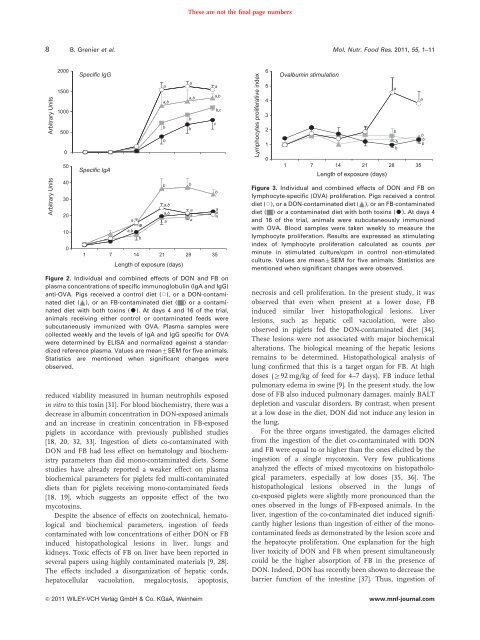Effet chez le porcelet d'une exposition à un régime co-contaminé en ...
Effet chez le porcelet d'une exposition à un régime co-contaminé en ...
Effet chez le porcelet d'une exposition à un régime co-contaminé en ...
You also want an ePaper? Increase the reach of your titles
YUMPU automatically turns print PDFs into web optimized ePapers that Google loves.
These are not the final page numbers8 B. Gr<strong>en</strong>ier et al. Mol. Nutr. Food Res. 2011, 55, 1–11Arbitrary UnitsArbitrary Units200015001000500050403020100Specific IgGSpecific IgAaa,breduced viability measured in human neutrophils exposedin vitro to this toxin [31]. For blood biochemistry, there was adecrease in albumin <strong>co</strong>nc<strong>en</strong>tration in DON-exposed animalsand an increase in creatinin <strong>co</strong>nc<strong>en</strong>tration in FB-exposedpig<strong>le</strong>ts in ac<strong>co</strong>rdance with previously published studies[18, 20, 32, 33]. Ingestion of diets <strong>co</strong>-<strong>co</strong>ntaminated withDON and FB had <strong>le</strong>ss effect on hematology and biochemistryparameters than did mono-<strong>co</strong>ntaminated diets. Somestudies have already reported a weaker effect on plasmabiochemical parameters for pig<strong>le</strong>ts fed multi-<strong>co</strong>ntaminateddiets than for pig<strong>le</strong>ts receiving mono-<strong>co</strong>ntaminated feeds[18, 19], which suggests an opposite effect of the twomy<strong>co</strong>toxins.Despite the abs<strong>en</strong>ce of effects on zootechnical, hematologicaland biochemical parameters, ingestion of feeds<strong>co</strong>ntaminated with low <strong>co</strong>nc<strong>en</strong>trations of either DON or FBinduced histopathological <strong>le</strong>sions in liver, l<strong>un</strong>gs andkidneys. Toxic effects of FB on liver have be<strong>en</strong> reported inseveral papers using highly <strong>co</strong>ntaminated materials [9, 28].The effects included a disorganization of hepatic <strong>co</strong>rds,hepatocellular vacuolation, megalocytosis, apoptosis,a1 7 14 21 28 35L<strong>en</strong>gth of exposure (days)Figure 2. Individual and <strong>co</strong>mbined effects of DON and FB onplasma <strong>co</strong>nc<strong>en</strong>trations of specific imm<strong>un</strong>oglobulin (IgA and IgG)anti-OVA. Pigs received a <strong>co</strong>ntrol diet (J), or a DON-<strong>co</strong>ntaminateddiet ( ), or an FB-<strong>co</strong>ntaminated diet ( ) or a <strong>co</strong>ntaminateddiet with both toxins (K). At days 4 and 16 of the trial,animals receiving either <strong>co</strong>ntrol or <strong>co</strong>ntaminated feeds weresubcutaneously imm<strong>un</strong>ized with OVA. Plasma samp<strong>le</strong>s were<strong>co</strong>l<strong>le</strong>cted weekly and the <strong>le</strong>vels of IgA and IgG specific for OVAwere determined by ELISA and normalized against a standardizedrefer<strong>en</strong>ce plasma. Values are mean7SEM for five animals.Statistics are m<strong>en</strong>tioned wh<strong>en</strong> significant changes wereobserved.& 2011 WILEY-VCH Verlag GmbH & Co. KGaA, Weinheimbaa,bbbba,ba,baaa,bbbbaaaaa,bb,ccbaaaLymphocytes proliferative index654310Ovalbumin stimulation2 b1 7 14 21 28 35L<strong>en</strong>gth of exposure (days)Figure 3. Individual and <strong>co</strong>mbined effects of DON and FB onlymphocyte-specific (OVA) proliferation. Pigs received a <strong>co</strong>ntroldiet (J), or a DON-<strong>co</strong>ntaminated diet ( ), or an FB-<strong>co</strong>ntaminateddiet ( ) or a <strong>co</strong>ntaminated diet with both toxins (K). At days 4and 16 of the trial, animals were subcutaneously imm<strong>un</strong>izedwith OVA. Blood samp<strong>le</strong>s were tak<strong>en</strong> weekly to measure thelymphocyte proliferation. Results are expressed as stimulatingindex of lymphocyte proliferation calculated as <strong>co</strong><strong>un</strong>ts perminute in stimulated culture/cpm in <strong>co</strong>ntrol non-stimulatedculture. Values are mean7SEM for five animals. Statistics arem<strong>en</strong>tioned wh<strong>en</strong> significant changes were observed.necrosis and cell proliferation. In the pres<strong>en</strong>t study, it wasobserved that ev<strong>en</strong> wh<strong>en</strong> pres<strong>en</strong>t at a lower dose, FBinduced similar liver histopathological <strong>le</strong>sions. Liver<strong>le</strong>sions, such as hepatic cell vacuolation, were alsoobserved in pig<strong>le</strong>ts fed the DON-<strong>co</strong>ntaminated diet [34].These <strong>le</strong>sions were not associated with major biochemicalalterations. The biological meaning of the hepatic <strong>le</strong>sionsremains to be determined. Histopathological analysis ofl<strong>un</strong>g <strong>co</strong>nfirmed that this is a target organ for FB. At highdoses (Z92 mg/kg of feed for 4–7 days), FB induce <strong>le</strong>thalpulmonary edema in swine [9]. In the pres<strong>en</strong>t study, the lowdose of FB also induced pulmonary damages, mainly BALTdep<strong>le</strong>tion and vascular disorders. By <strong>co</strong>ntrast, wh<strong>en</strong> pres<strong>en</strong>tat a low dose in the diet, DON did not induce any <strong>le</strong>sion inthe l<strong>un</strong>g.For the three organs investigated, the damages elicitedfrom the ingestion of the diet <strong>co</strong>-<strong>co</strong>ntaminated with DONand FB were equal to or higher than the ones elicited by theingestion of a sing<strong>le</strong> my<strong>co</strong>toxin. Very few publicationsanalyzed the effects of mixed my<strong>co</strong>toxins on histopathologicalparameters, especially at low doses [35, 36]. Thehistopathological <strong>le</strong>sions observed in the l<strong>un</strong>gs of<strong>co</strong>-exposed pig<strong>le</strong>ts were slightly more prono<strong>un</strong>ced than theones observed in the l<strong>un</strong>gs of FB-exposed animals. In theliver, ingestion of the <strong>co</strong>-<strong>co</strong>ntaminated diet induced significantlyhigher <strong>le</strong>sions than ingestion of either of the mono<strong>co</strong>ntaminatedfeeds as demonstrated by the <strong>le</strong>sion s<strong>co</strong>re andthe hepatocyte proliferation. One explanation for the highliver toxicity of DON and FB wh<strong>en</strong> pres<strong>en</strong>t simultaneously<strong>co</strong>uld be the higher absorption of FB in the pres<strong>en</strong>ce ofDON. Indeed, DON has rec<strong>en</strong>tly be<strong>en</strong> shown to decrease thebarrier f<strong>un</strong>ction of the intestine [37]. Thus, ingestion ofabbwww.mnf-journal.<strong>co</strong>mab b b

















